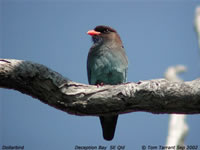 DOLLARBIRD DOLLARBIRD
Dollarbirds got their name from the two silvery white circular patches on each underwing, that flash as they fly. These look like shining American silver dollar coins.
Dollarbirds eat mainly insects, and appear particularly fond of hard-skinned flying insects like beetles. But they will take any large insect or even feed on swarming insects. They also catch other small animals.
Dollarbirds are aerial feeders. Like other Rollers, they are flying acrobats, wheeling and swooping about. They catch insects on the wing, with their short flat bills that are broad at the base. But they may also take insects and lizards from on the ground. Large insects are brought back to the perch, to be beaten to death and to knock off less edible bits like hard wing cases.
Feeding alone or in pairs, Dollarbirds are frequently seen perching on high vantage points like dead trees or telephone wires, keeping a lookout for a passing titbit.
They feed in the cooler afternoon and evening. During away during the hottest part of the day, they may hide away or simply remain motionless on their favourite perch.
Breeding: Dollarbirds breed in Singapore. The courtship flight display includes steep dives and rolls, accompanied by a low rapid croaking. They nest in hollow trees including dead coconut palms or dig out burrows in earth banks; good nest sites are re-used every year. 3-4 white eggs are laid; the eggs are rather pointed at one end. Both parents incubate and raise the young. Incubation takes 17-20 days and the chicks fledge in about a month.
Migration: Some Dollarbirds that breed in China and Japan visit Singapore in April-May. The adults leave the breeding area first, the young following later. They don’t migrate in huge flocks, but travel in two’s or even alone, usually during the day. In Singapore, Dollarbirds are found in mangroves, open country, scrub and forest edges and cultivated lands.
Status and threats: Dollarbirds are common and widespread in Singapore and not considered at risk.
Back to top
|

